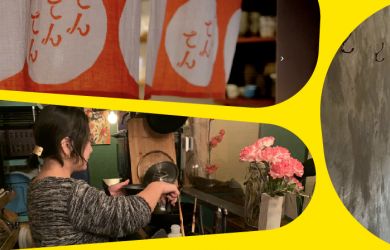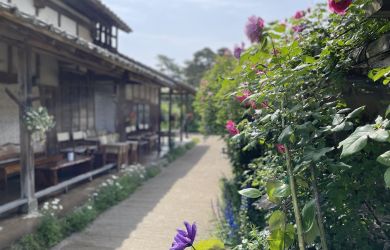
Tobe-yaki Ceramics

Drive 40 minutes from the center of Matsuyama to encounter a slender 15m-high white tower, which marks the entrance to the town of Tobe. It’s decorated with 560 china plates from each of the local potters, as a symbol of the town. It was built to show future generations the passion of Tobe’s ceramists, and to catch the imagination of visitors.
Tobe-yaki is a traditional Japanese industrial art using materials produced in the area. Typical designs have a pure white base with characteristic designs in indigo blue. These beautiful works have devotees from all over Japan, thanks to their robustness and practicality.
In recent years, young ceramists have been eschewing traditional materials and designs, taking Tobe-yaki in new directions, and maintaining the character of the town, with its flourishing industry based around craftsmanship.
The Shikoku Pilgrimage

The Shikoku Pilgrimage is a circular route taking in 88 Buddhist temples on Japan’s fourth island. These temples are associated with the Buddhist monk Kukai, more generally known as Kobo Daishi, who founded the Shingon sect of Buddhism. The pilgrimage is an integral part of Shikoku’s culture, and the gentle welcome offered to ohenro (pilgrims) is extended equally to other visitors. 2014 is an auspicious year to undertake the route, as it marks the 1,200th anniversary of the pilgrimage.
In the past, all ohenro walked, but today many go by bicycle, car, or bus, often doing the pilgrimage in stages over a period of time. The spectacular temples in Ehime include Ishiteji in Matsuyama, and Iwayaji in Kuma Highland.
Spring water
Located between the sea and Mt. Ishizuchi, Saijo is a city known for its spring water. Ishizuchi, the highest mountain in western Japan, is white with snow in winter. As the snow melts, the water seeps into the ground and emerges again from a multitude of springs. These are called uchinuki. This clean, sweet water from the snows of Ishizuchi refreshes the people of Saijo in the hot months, and provides one of the key ingredients of the area’s excellent sake.
Uchinuki bubble forth in many public places and you can take a tour of the springs on foot or by bike. One of the most impressive rises from the sea at the mouth of the Honjin River. It’s dedicated to Kobo Daishi, founder of the Shikoku Pilgrimage.
Shimanami Kaido Cycling

A chain of islands straddles the Inland Sea between Imabari in Ehime, and Onomichi in Hiroshima. These are linked by the Shimanami Kaido, a highway with spectacular suspension bridges over the sea passages. Unlike most expressways, the Shimanami Kaido has a lane for pedestrians and cyclists.
The ability to cross this spectacularly beautiful island route on a bicycle offers a bonanza for cyclists of every sort, from casual day trippers to serious riders who eat up the miles. It’s also very attractive for motorists and motorcyclists, but cycling is perfect for gazing at the scenery, and peering over the railings at the ships passing below amid the fascinating currents of the sea.
Although it’s possible to complete the route in a single day, it’s best to dedicate some time for exploring the islands. For cyclists without their own bikes, there are rental stations along the route offering all sorts of models at reasonable rates. You can even rent at one place and drop off at another for ultimate flexibility, and the route is served by buses and ferries to Shikoku and Honshu. You can also get a bus between Imabari and Hiroshima, while a regular ferry links Matsuyama and Hiroshima.
Each island has its own character and attractions. Omishima has several art galleries and Oyamazumi Shrine with its treasure house of samurai weapons. Hakata has a number of wonderful beaches and celebrated cherry blossoms. And Oshima has fascinating folk and history museums where you can learn about the samurai-pirates who made these islands their home. Each island has a choice of accommodation and restaurants, making it easy to plan your own tour.
Many visitors who cycle the Shimanami Kaido have blogged that it was their most satisfying experience in Japan.
Cormorant Fishing
[pictured top]
Ukai is a traditional method of catching river fish using cormorants. Ozu is one of the three major places in Japan where this splendid water show can still be seen.
A roofed pleasure boat takes you out on the Hijikawa River, where a dinner of local cuisine is served. Watching the master managing his team of birds and throwing the fish into his boat is an impressive sight. Ukai is held during the daytime and at night, so you can enjoy the performance with a backdrop of the beautiful scenery around the river, or with dramatic torchlight at night. The cormorants are treated as family by the fishermen, and they typically live longer, healthier lives than their cousins in the wild. Watching cormorant fishing is an entertainment for the warmer months.
Underwater Sea Walker

Did you ever want to try diving, but lacked the time and money? Well here’s your chance to experience the undersea world without any elaborate preparation. Just change into a wetsuit, put on a funky “Sea Walker” bubble helmet, and you’re ready to go. Walk down some steps to the sea floor, and you’re free to wander about among the coral and fish of the beautiful Uwakai Sea.
Thanks to the Sea Walker helmet, your hair doesn’t even get wet and you can wear your contact lenses or glasses with no worries. Since there’s no swimming involved, it doesn’t matter if you can’t. And to ensure safety, a qualified guide is with you all the time.
For a modest ¥6,000 for adults and ¥4,000 for kids, drop in and surprise some fish any time it takes your fancy.
Nametoko Gorge Canyoning
Canyoning is a river sport that originated in Europe. It’s one of the most exciting ways to experience nature, as you descend through rocky gorges formed naturally over thousands of years by the action of rivers. Intrepid canyoners abandon themselves to the flow of the river to slide and slither down rocky chutes, and test their nerve by jumping many meters into the basins of waterfalls or rappelling down from the top of huge rocks. Nametoko Gorge in the southwest part of Shikoku is the premiere canyoning spot in Japan, offering an enormous range of natural chutes, slides and rappelling spots. There are reasonably priced half day and full day courses. But for the less extreme nature lover, Nametoko is a beauty spot in its own right, with miles of hiking trails, a campsite, and rocky pools for summer swimming.


Ehime Festivals
The Saijo and Niihama festivals in the Toyo area of Ehime are held in mid October to celebrate the autumn harvest. They feature huge brocaded danjiri, a kind of festival juggernaut, mikoshi portable shrines, and taikodai drum wagons. The biggest drum wagon is over five meters high and weighs about two and half tons. The festivals involve pushing these immensely heavy structures through the streets of the city, and gathering here and there for displays called kakikurabe. This translates roughly as “comparing who can trolley about with the most glory and bravado.” As if wheeling the juggernauts up and down in various formations is not enough, they’re also hoisted into the air by a hundred men or more, who struggle and grunt under huge supporting poles. Much beer and sake is consumed to keep everybody in tip-top condition. In Niihama, the juggernauts take to the sea, whereas in Saijo they end up in the river.
• International Affairs Division, Ehime Prefectural Government
• Tel: 089-912-2311; fax: 089-921-5931
• Email: kokusai@pref.ehime.jp
• http://iyokannet.jp





